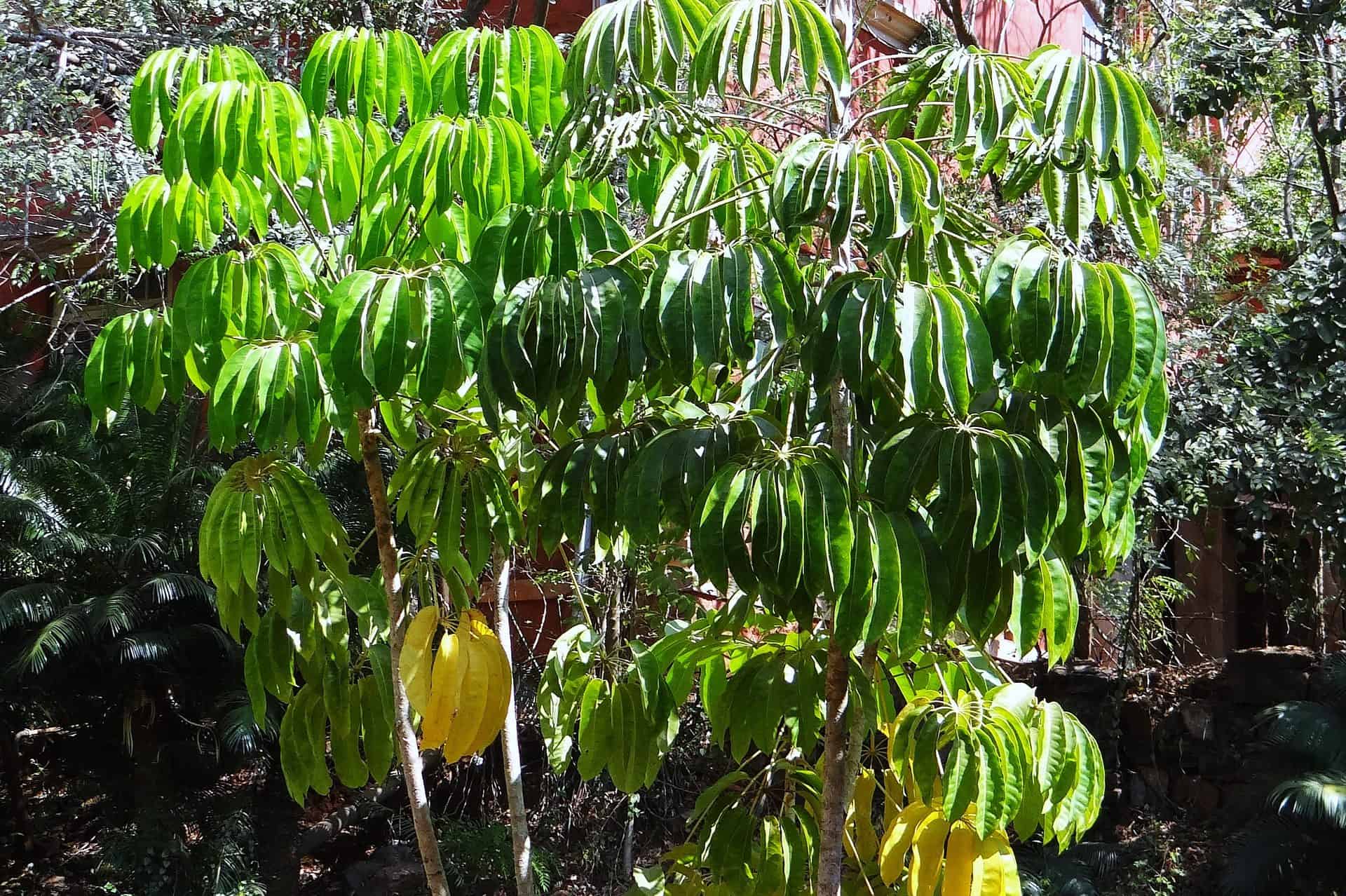It’s impossible not to love a plant with shiny, beautiful leaves and a beautiful shape. Schefflera plants are easy to find these days, and I’ve grown a lot of them over the years. This is my favorite, though. Here are some tips on how to take care of and grow Schefflera Amate so that your home has some wild and wonderful tropical vibes.
Most houseplants are native to the tropics or subtropics and the Amate is no different. What sets it apart and kicks it up a notch is the abundance of large leaves. This plant, which is often called an “umbrella tree,” is easy for me to take care of, even in the desert where I live in Arizona. I think you will too.
The schefflera amate is a gorgeous indoor plant known for its lush tropical foliage. With large, glossy leaves it adds a wonderful pop of green to any indoor space. While schefflera amate thrives outdoors in its native tropical habitats, it can also make an excellent houseplant if cared for properly. In this complete guide, we’ll go over everything you need to know to successfully grow schefflera amate indoors.
Overview of Schefflera Amate
Schefflera amate is a fast growing tree that can reach up to 65 feet tall in its natural rainforest environment. It is native to Australia and New Guinea. The common name, umbrella tree, refers to the beautiful umbrella-like arrangement of its leaves. Schefflera amate features shiny, bright green leaves that can grow quite large, up to 3 feet long!
This plant is an excellent choice for beginners, as it adapts well to indoor conditions. It is less picky than other schefflera varieties when it comes to care. With medium to bright, indirect light, schefflera amate will flourish indoors.
Light Requirements
Schefflera amate thrives in medium to bright indirect light. It can tolerate lower light conditions but growth will slow. Place your schefflera amate near an east or north facing window where it will get consistent indirect sunlight. Avoid direct hot sun especially from southern or western exposures, as this can scorch the leaves.
If you’re unsure of the lighting conditions in your home, use a light meter app on your phone to get an accurate reading. Schefflera amate does best with 200-800 FC of indirect light. Rotate the plant every so often so all sides get even light exposure.
Watering and Soil Needs
Schefflera amate prefers soil that is evenly moist but not soggy. Allow the top inch or two of soil to dry out between waterings. Water thoroughly until it drains freely from the drainage holes at the bottom. Take care not to overwater, as schefflera amate is prone to root rot if left in standing water.
Use a well-draining potting mix made for tropical plants. Amend with perlite or orchid bark to improve drainage. The soil should retain some moisture but also have air pockets for the roots.
Humidity
As a tropical rainforest plant, schefflera amate prefers average to high humidity. The minimum recommended level is 40%. Low humidity can cause leaf tip burn, brown edges, or excessive leaf drop.
Use a humidifier nearby to increase moisture in the air. Place the pot on a pebble tray filled with water, keeping the pot above the water line. Misting the leaves every few days will also boost humidity.
Temperature
Normal indoor temperatures between 60-80°F are ideal for schefflera amate. Avoid exposing it to cold drafts or hot air vents. This plant cannot tolerate temperatures below 50°F or rapid temperature fluctuations.
Fertilizer
To fuel growth and keep the foliage lush, fertilize schefflera amate every 2-4 weeks during spring through fall. Use a balanced liquid fertilizer diluted to half strength. Reduce frequency to monthly in winter. Flush the soil with plain water every few months prevent fertilizer buildup.
Pruning
To maintain its desired size and shape, prune back the new growth on your schefflera amate. Make cuts just above leaf nodes using clean, sharp shears. You can prune in early spring to shape the plant. Remove any dead or damaged growth as needed.
Propagation
Propagate schefflera amate from stem cuttings or through air layering:
-
Stem cuttings – Take 4-6 inch cuttings in spring or summer. Remove lower leaves and place in water or moist potting mix. Keep warm and humid until roots form.
-
Air layering – Make a 2 inch cut on a stem, wrap with sphagnum moss, then wrap in plastic. When roots form in the moss, detach and pot up.
Common Problems
Here are some common issues you may encounter when growing schefflera amate:
-
Drooping leaves – Usually caused by under watering. Check soil moisture.
-
Leaf spotting – Sign of overwatering. Allow soil to dry between waterings.
-
Leaf drop – Can indicate inadequate humidity or light.
-
Mealybugs – Treat with insecticidal soap. Isolate affected plants.
-
Root rot – Repot in fresh, well-draining soil. Don’t overwater.
Tips for Growing Schefflera Amate Indoors
-
Provide brightly lit spot, but avoid direct hot sun. East or north facing window ideal.
-
Water when top inch of soil is dry. Don’t let sit in soggy soil.
-
Mist leaves or use pebble tray to boost humidity. 40% minimum recommended.
-
Repot every 2 years in spring using tropical plant potting mix.
-
Wipe leaves often with damp cloth to keep foliage clean and shiny.
-
Rotate plant periodically for even light exposure and growth.
-
Prune as needed in spring to maintain desired size and shape.
With its huge, glossy tropical foliage, schefflera amate makes a wonderful accent plant for indoor spaces. Follow this schefflera amate care guide for light, water, humidity, pruning, and troubleshooting advice. Proper care will keep your umbrella plant healthy and looking its best for years to come!
Schefflera Amate Care and Growing Tips
I’ve done a previous post and video on Schefflera Amate care but that was a few years ago. Like everything else, my blogging style changes over time. I wanted to write a more in-depth post about how to take care of this beautiful plant that I love for many reasons.
The Schefflera Amate has a beautiful, rounded form. It’ll develop into a tree form as it ages but you can pinch it back to prevent that. Because it gets a little wider as it gets taller, it takes up some space in your house. If you don’t have much room, check out the Dracaena Lisa because it grows in a much narrower shape.
This plant grows to around 10′. When grown outdoors, it can get taller. I bought mine in a 10-inch pot that was about 4-feet tall, but I’ve also seen them in 6-inch and 8-inch pots.
The Schefflera Amate grows moderate to fast indoors. Outdoors it grows fast.
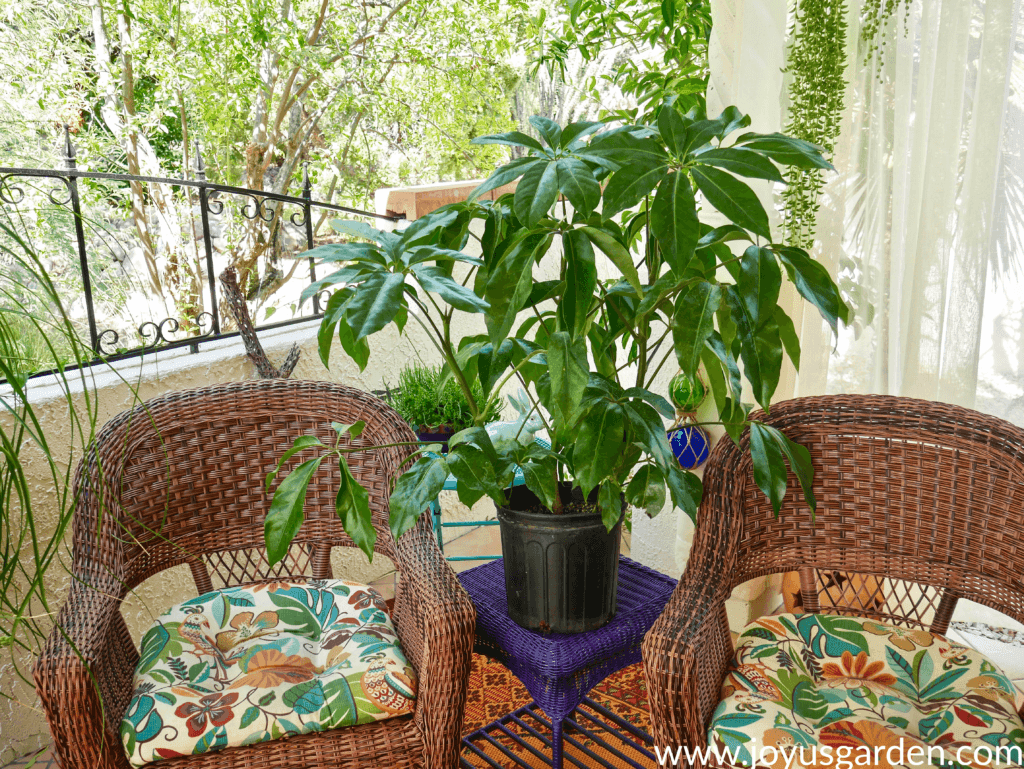
My Amate lookin’ good on the side patio for the filming. It’s in a 10″ pot now & I’ll transplant it into a 14″ one next spring.
Medium light is best. For instance, mine sits in a north facing window where it gets natural light all day long. Remember, I live in Tucson AZ where we get A LOT of sun all year long. An east or south exposure might be better for yours depending on where you live.
High light is fine too as long as it’s not in or close to a hot, sunny window. It can handle less light, but it won’t grow as quickly and won’t have as good of a shape.
I rotate my plant every 3 months so it gets light on both sides. Otherwise, your Schefflera will start to lean towards the light source & grow in a 1-sided way. If you live somewhere where it gets darker in the winter, you might need to move your plant to a place with more light for a few months.
Like most houseplants, this 1 doesn’t like to be kept consistently moist. Overwatering will lead to root rot & then leaf spot & perhaps powdery mildew. I water mine thoroughly every 7 days here in this hot climate. In winter I back it off to every 9-14 days depending on the weather.
There is a post called “houseplant watering 101” that will help you figure out how often to water your plants.
As I always say, if your home is comfortable for you, it’ll be so for your houseplants too. Just be sure to keep your Schefflera away from any cold drafts & air conditioning or heating vents.
It’ll take temps down to 30F when grown outdoors.
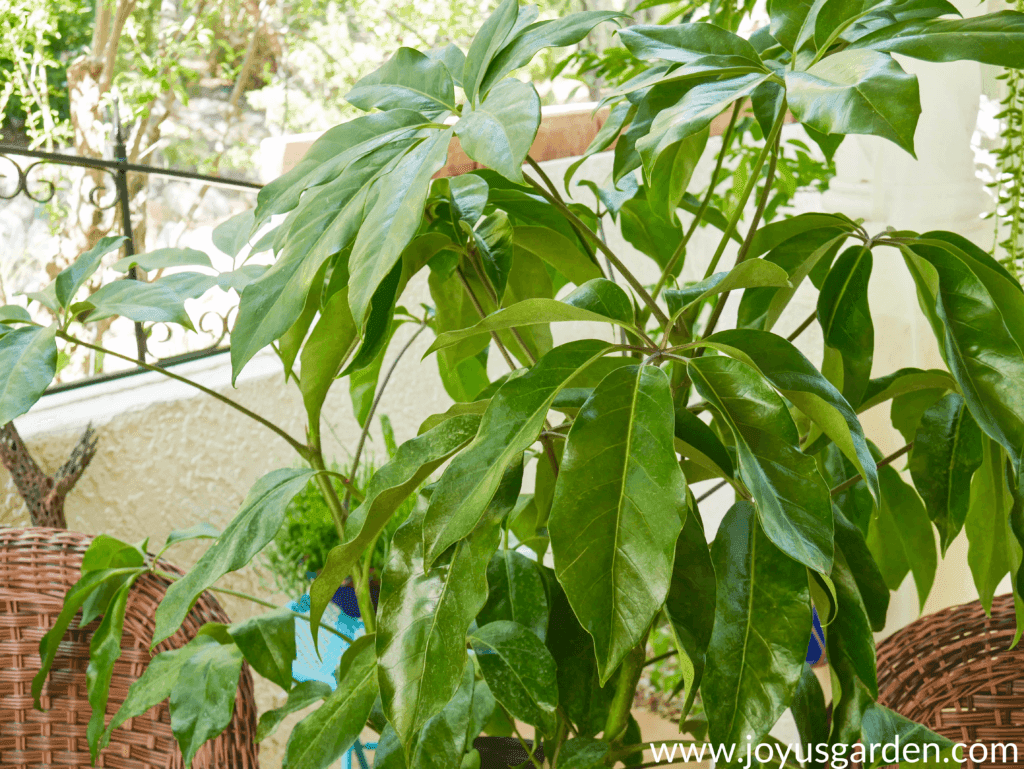
Oh, that fabulous foliage. And look Ma, no brown tips!
Scheffleras are native to the subtropical & tropical rainforests. That being said, they do just fine in our homes which tend to have dry air. See the picture above? Mine doesn’t have any brown tips at all where I live in hot, dry Tucson.
If you think yours looks stressed due to lack of humidity, fill the saucer with pebbles & water. Place the plant on the pebbles, but check to see if the holes for drainage are clear. Misting a few times a week would also be appreciated.
I don’t fertilize mine but that might change soon because I’m experimenting with a concoction. I’ll let you know. In the spring, I put a thin layer of worm compost on top of the worm compost I use to feed my houseplants. Easy does it – 1/4 to 1/2″ of each for a larger sized houseplant. Read about my worm compost/compost feeding right here.
Liquid kelp or fish emulsion would work fine too as well as a balanced liquid houseplant fertilizer (5-5-5 or lower) if you have that. Dilute any of these to half strength & apply in spring. If for some reason you think your Amate needs another application, do it again in summer.
You don’t want to fertilize houseplants in late fall or winter because that’s their time for rest. Don’t over fertilize your Schefflera Amate because salts build up & can burn the roots of the plant. Avoid fertilizing a houseplant which is stressed, ie. bone dry or soaking wet.
Any good quality preferably organic potting soil is fine. Just be sure it’s formulated for houseplants which it’ll say on the bag. I now use Smart Naturals by Fox Farm. It has lots of good stuff in it.
I always have coco coir on hand & add that in with the potting soil in a ratio of 1:3(ps). Growers love coco coir as a growing medium because it holds water well yet still provides good drainage & aeration. It’s much more environmentally friendly than peat moss which is considered to be a non-renewable resource but has all the same properties.
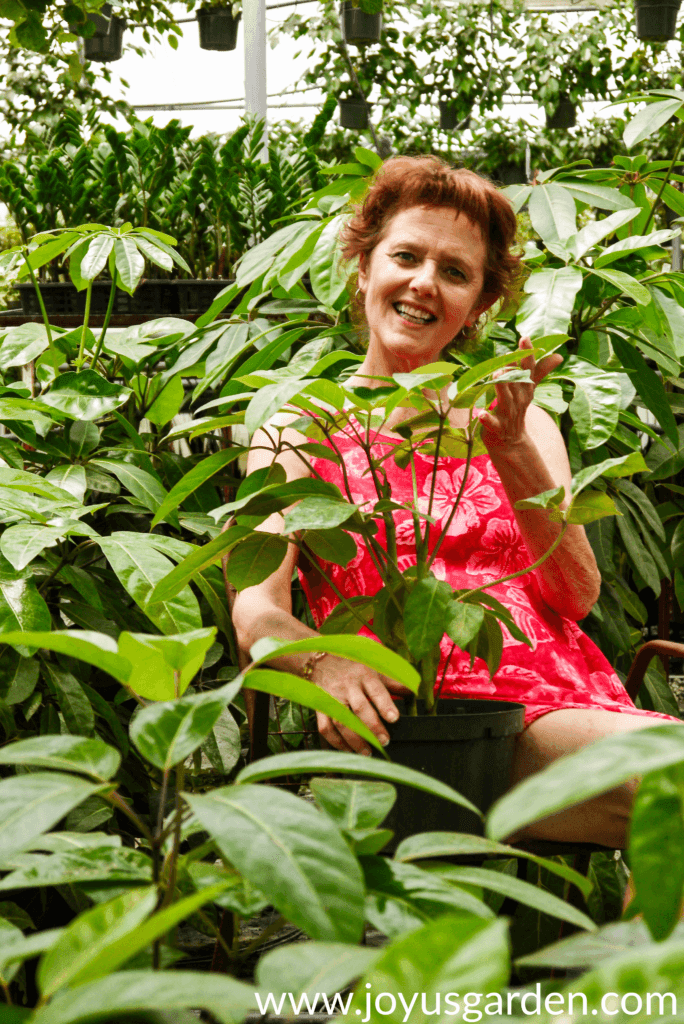
The pictures for our book Keep Your Houseplants Alive were mostly taken at Santa Ynez Gardens, a wholesale nursery, in the Amate forest. This is me hanging out there.
This is best done in spring or summer; early fall is fine if you’re in a warm climate. The faster your plant is growing, the sooner it’ll need repotting. I wouldn’t keep a Schefflera Amate too tight in its pot like some other houseplants.
I can see the fine roots in the drain holes of grow pot of mine. I’ll repot it in early spring into a 14″ pot. It’s in a 10″ pot now & I’ll skip the 12″ pot & go straight to 14″. You can do that with this plant.
The main reasons to prune this plant are for propagation &/or to control the size. Mine grows in the bedroom where the ceilings are 9′ tall. I’ll tip prune it when my Schefflera is around 7 1/2′ to 8′ tall. I show you how I’ll do it in the video.
Just make sure your pruners are clean & sharp before you do any pruning.
I think you can grow this plant from tip cuttings, but I’ve never done it myself. If you have, please let us know.
The preferred method which has worked for me is air layering. I did this successfully on a Schefflera pueckleri or Tupidanthus which is a close relative of the Amate. I’m air layering 1 of my Ficus elasticas so that video & post will be coming up soon.
Just like transplanting, this is best done in spring or summer.
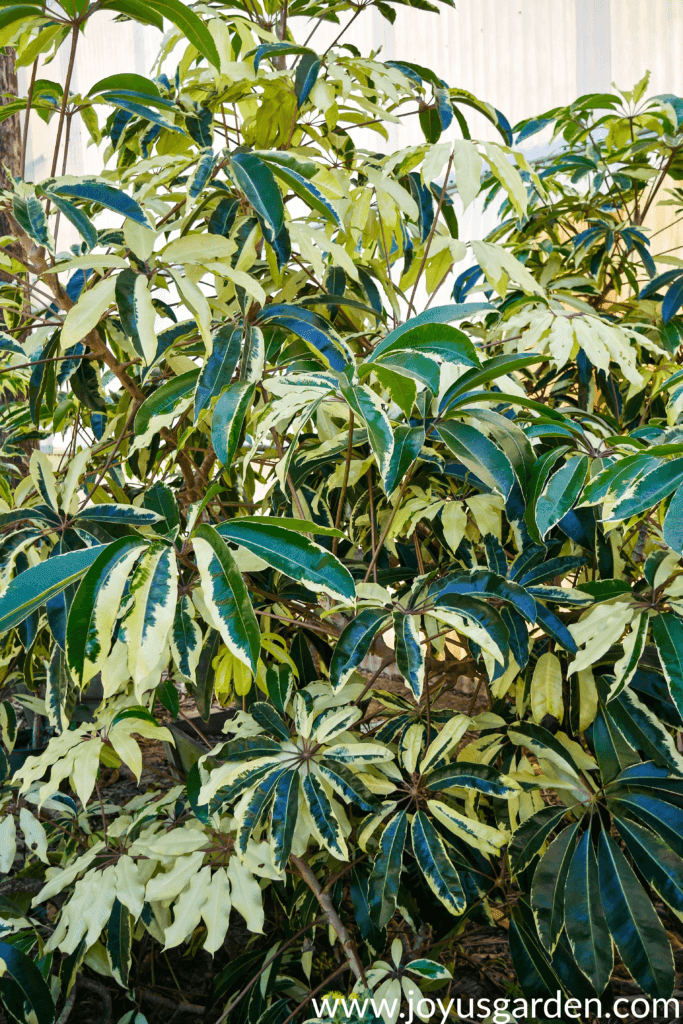
09 Here’s the variegated version of the schefflera I air layered. This is Schefflera pueckleri “variegata” or Variegated Tupidanthus. I haven’t seen this snazzy plant to often & wanted to share it with you.
Mine have never gotten any. When I worked as an indoor landscaper, spider mites, mealy bugs, and scale were common on all Scheffleras. This was especially true when the heat came on in offices as the temps outdoors cooled.
The Amate has been bred to be less likely to get spider mites. Read more about that in “Good To Know.” Click on the links above
There is nothing specific about the Amate & toxicity. Because other Scheffleras are considered to be toxic to dogs & cats, I’d make a bet this 1 is too. I always refer to the ASPCA website for this info & you can read about the effects this plant has on pets here.
I’ve done a post on toxicity & houseplants plus safe choices for pets which might interest you.
How to Take Care of That Schefflera Amate
Is Schefflera a good houseplant?
Schefflera is a lively and lush houseplant that features leaves that form a pattern that looks like an umbrella. This gives it its common name ‘Umbrella Tree’ and makes it a fun addition to any home. It makes for a great houseplant as it is very tolerant of indoor conditions. Schefflera is native to Australia, as well as New Guinea.
Can Schefflera amate grow in cold weather?
Schefflera amate prefers warm temperatures, and grows best when allowed to warm up during the day. Never let night temperatures drop below 65 degrees F (18 degrees C) or the plant may began shedding leaves. Keep away from drafts of cold air or blasts of heat from heating and cooling vents, as this can cause the plant to drop leaves.
What is Schefflera amate?
Schefflera Amate is a select cultivar of the Umbrella tree (Schefflera) is a leafy green plant found in the flourishing rainforests of Australia. [DETAILS]
How big does a Schefflera amate grow?
In an indoor environment, the schefflera amate typically grows anywhere from five to ten feet, the average being eight. Despite being a tropical plant, it adapts to numerous types of environments – one of the various reasons it makes a great indoor plant. Of course, its appearance certainly makes a wonderful addition to any home or office.
- The Ultimate Guide to Growing Strawberries in Raised Beds - August 8, 2025
- No-Dig Garden Beds: The Easiest Way to Grow a Beautiful Garden - August 6, 2025
- How to Protect and Preserve Wood for Raised Garden Beds - August 6, 2025

